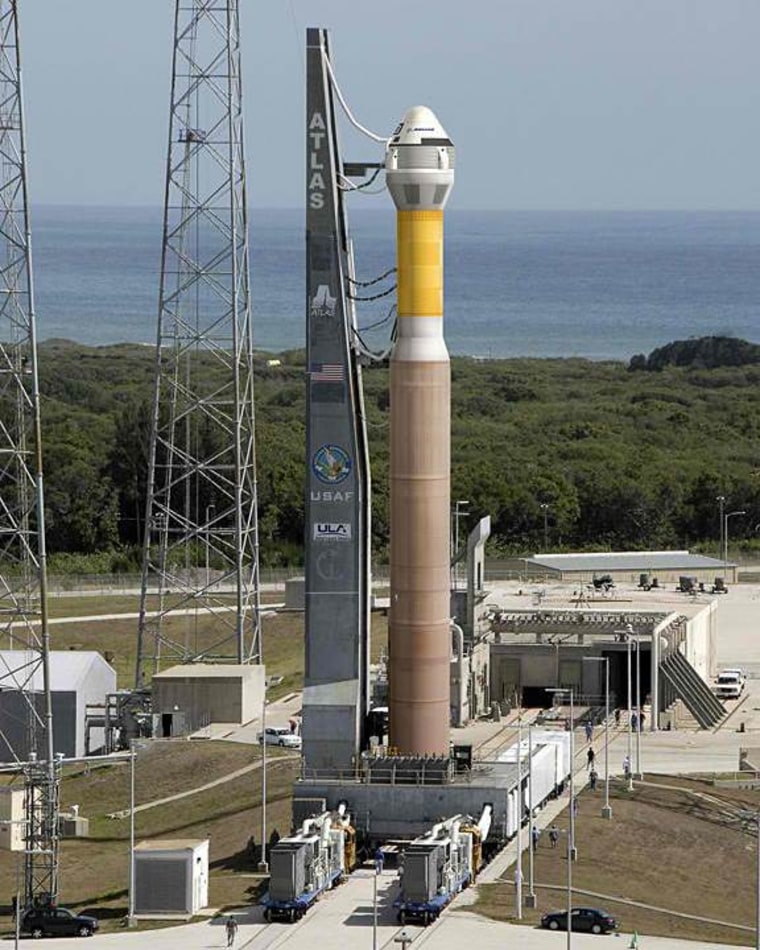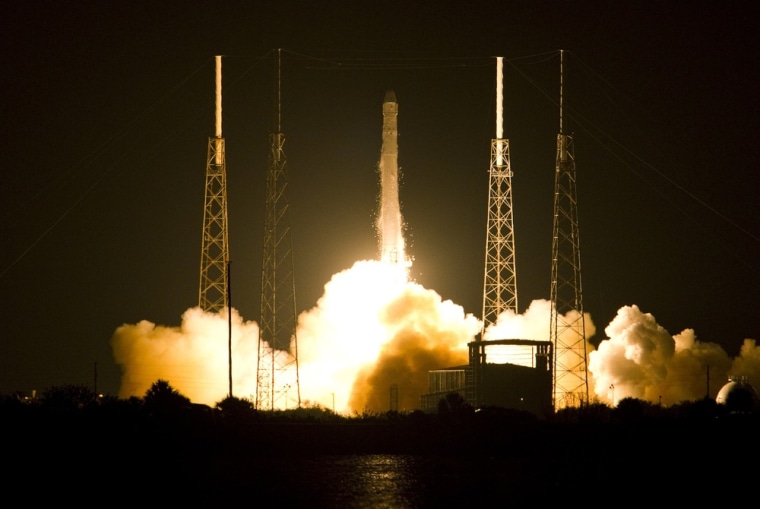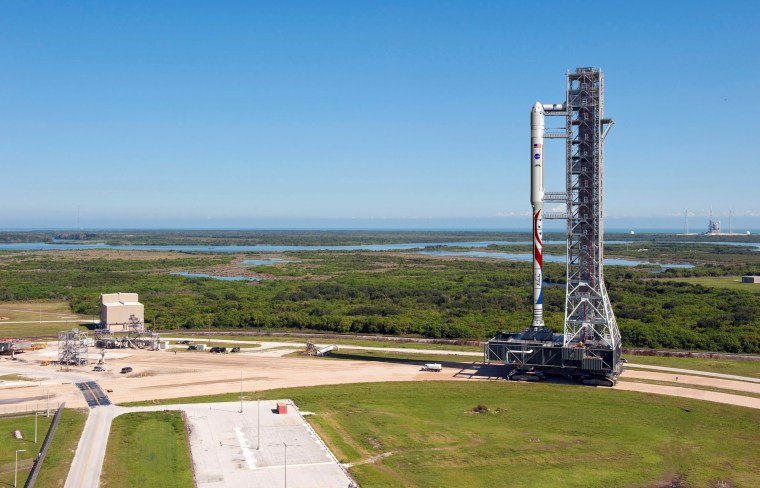If astronauts are launched from American soil once again during the next presidential term, they'll almost certainly be riding a rocket called Liberty, Atlas or Falcon.
Those are the rockets being offered as the main contenders in a new commercial space race to carry NASA's spacefliers to the International Space Station. So which one is the most ready to go?
SpaceX's Falcon 9 rocket and Dragon capsule have taken up most of the spotlight to date, thanks to May's successful cargo-carrying mission to the International Space Station. But this old curmudgeon sees the situation differently, as do some other longtime observers of the space program.
The way it looks from here, Liberty is the best bet, with United Launch Alliance's Atlas 5 a close second, and SpaceX third.
Why?
Because Liberty draws upon three decades of tested technology: The rocket's first stage is a space shuttle solid rocket booster with five segments instead of four. The booster has had 221 successful launches in a row — the most ever. A version of Liberty was tested under the name Ares 1-X in 2009. Everything the launch system needs remains standing. Even the 600 high-tech workers whose jobs were outsourced to Russia since last year's retirement of the shuttle fleet are still in the neighborhood.
The launch vehicle, incorporating the solid-fuel first stage and an upper stage based on the tried-and-true Ariane 5 rocket, would be assembled here at Kennedy Space Center's massive Vehicle Assembly Building. Its service tower is here, too, paid for but never used. There's a crawler-transporter ready to carry it, a launch control center ready to monitor the countdown — and the same seaside launch pad used to launch Liberty's first version, the Ares 1-X.
Liberty is designed to lift 44,500 pounds, the most weight carried by any of America's single rockets. It would be outfitted with the Max Launch Abort System, an advanced crew-escape system that was built and tested by NASA itself. Liberty's lightweight composite spacecraft is also a built-and-tested NASA product — and the good news is that its working parts and systems would be put together by Lockheed Martin, the same people building NASA's Orion deep-space ship.
Despite all these pluses, the commercial Liberty project hasn’t received a single dollar from NASA. Its team includes ATK, Astrium, Lockheed Martin, and 12 other subcontractors that fly history’s safest space hardware, sustaining thousands of jobs across 10 states. If Liberty is eventually selected to fly America’s goods, the team plans about 600 rehires from the space shuttle launch team.
Liberty could carry to seven astronauts into Earth orbit, not only aboard its own lightweight taxi, but aboard virtually all commercial spacecraft being offered, including the big one itself, the Orion.
The two other favorites
Simply put, the Liberty launch system can do more than Russia's Soyuz for less money. The same can be said, of course, for the two other entrants in the rocket race, United Launch Alliance's Atlas 5 and SpaceX's Falcon 9.

The Atlas 5 has been launched successfully 31 times in a row from its Cape Canaveral Air Force Station launch pad, just south of the Kennedy Space Center. The pad is in direct view of NASA's launch control center. It can carry Boeing's CST-100 spacecraft, or Sierra Nevada's Dream Chaser, or even Blue Origin's Orbital Space Vehicle — all of which have been receiving development funds from NASA.
If NASA is smart enough to fly both Liberty and Atlas, American astronauts should never be without a rocket again. The two rockets could serve as backups for each other. If not, NASA's $6.6 billion Kennedy Space Center could be without a launch for five years or more. Its remaining 8,500 employees will have little to do except watch the grass grow.
How about SpaceX?
The company's cargo flight in May was a great success, and in time it could be just as successful launching astronauts into orbit. SpaceX's founder, Elon Musk, has said the Falcon 9 and Dragon capsule could put astronauts into orbit in three years. That's possible — but based on past delays in SpaceX's launch schedule, that doesn't seem likely to me.
SpaceX is going to have to execute a $1.6 billion NASA contract to fly 12 unmanned cargo flights to and from the space station over the next four years. It has other contracts to fulfill as well. In order to get the cargo-carrying Dragon cleared for carrying humans, the company will have to prove out upgrades in the Falcon's engines, develop a launch escape system, enhance environmental controls and install seats as well as control panels for astronauts.
The launch escape system is SpaceX's longest lead item. The company has already tested the SuperDraco engines that will be used by the escape system, but its launch facilities will have to be "human-rated," and then all the hardware and systems will have to pass NASA's safety muster. It's a Herculean effort that calls for 20 flights before launching humans.
SpaceX's impressive Dragon flight in May confounded many of the doubters, but experience is experience: SpaceX has launched rockets from its Cape Canaveral complex only three times, while the companies behind the Liberty and Atlas rockets have had dozens of successful liftoffs.

NASA team faces tough choices
The United States needs its own rocket and spacecraft, and the thousands of high-tech workers who lost their jobs when the space effort was outsourced to Russia need work. NASA has suffered serious setbacks, but I have to say it right here: In spite of it all, no one has done a better job managing the space agency than its current administrator and his deputy.
It’s been an unfair road for NASA Administrator Charlie Bolden, who started out as a young black man from the segregated South. Despite the odds, he made it through the halls of the U.S. Naval Academy, then served as a fighter pilot, a test pilot and a four-time space shuttle astronaut and commander. On top of all that, he's a retired two-star Marine Corps general. But even more important, he's a gentle man, warm and approachable with good humor and good will — an all-around affable person.
By his side is another sturdy hand — another all-around pleasant person, his deputy, Lori Garver. She cut her teeth in the space business as an intern in John Glenn's presidential campaign, and she's been on the rise ever since.
I've witnessed every day of NASA’s history. I sit here looking across launch pads with clear memories of the first flights by Alan Shepard and John Glenn. I remember standing there and shouting into a microphone when each Apollo flights left for the moon, and manning the microphone for three decades more as hundreds of astronauts were launched on 135 space shuttle missions.
I doubt seriously if anyone is seeking the advice of this old curmudgeon. But for what it's worth, I’m going to give it. Charlie and Lori, the companies involved in this commercial space race are taking no prisoners. The competition is fierce. This is the time you must make your best judgment for your country. Choose the most experienced partners. Choose the least costly path. Support the Liberty team, as well as the team behind Boeing's CST-100 and ULA's Atlas 5, as well as SpaceX. America’s space family needs work. They need to get their jobs back from Russia, and America’s astronauts need the feel of their own launch pads under them.
Safety first
All of the teams in the race are devoted to flying astronauts safely. There's no sign that anything about any of the spacecraft being developed for this space race is even potentially unsafe. But over the long run, experience is experience.
I remember meeting with astronaut Gus Grissom a few days before the Apollo 1 launch-pad fire in 1967. NASA had recently made a switch from McDonnell Aircraft, the prime contractor for Project Mercury and Gemini, to a new contractor named North American Aviation. Grissom begged me to reason with Apollo management. "Nothing really works on that spacecraft, Jay," he said. "We can’t even talk to the blockhouse."
After that talk, Apollo launch manager Rocco Petrone reassured me all was well. But even today, 45 years later, it still haunts me that I should have done more. I should have tried harder to save the lives of Gus Grissom, Ed White, and Roger Chaffee.
A similar lack of experience, mixed with overconfidence, played a role in the near-catastrophe of Apollo 13 in 1970, the loss of the shuttle Challenger in 1986, and the failure to see a hole in Columbia's wing in 2003.
Charlie and Lori, as you move ahead with plans for spaceflight in the 20-teens, turn to the experienced space workers who have suffered so much in the past year. Give America proven flight hardware. Don't gamble with this country's space effort.
Caution is the better part of spaceflight.
'Spaceflight in the 20-teens':
- Part 1: Space needs a place on to-do list
- Part 2: It's decision time for future spaceflight
- Part 3: Handicapping the commercial space race
- Part 4: Neil Armstrong still chooses to go to the moon
- Part 5: Small steps toward a giant leap in space
Cape Canaveral correspondent Jay Barbree is in his 55th year with NBC News. Barbree wrote the New York Times best-seller "Moon Shot" with Alan Shepard, and was a finalist to be the first journalist in space. His space team received an Emmy for broadcasting the Apollo 11 moon landing in 1969. Barbree broke the news about the cause of the 1986 Challenger shuttle accident on NBC Nightly News and is a recipient of NASA’s highest medal for public service. An updated version of published by Open Road Integrated Media, is available from , , , and .
